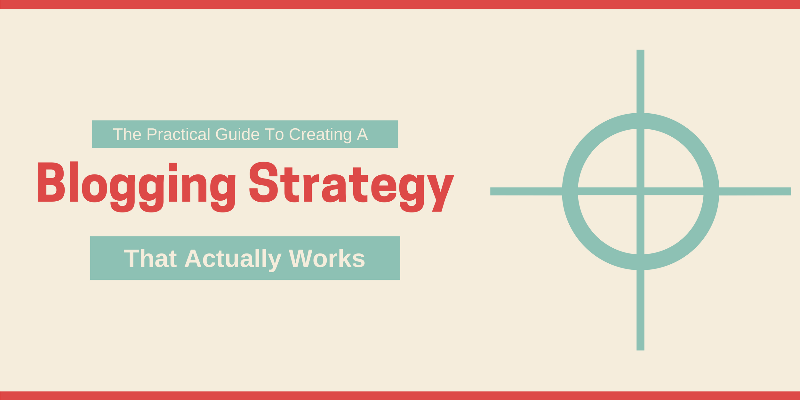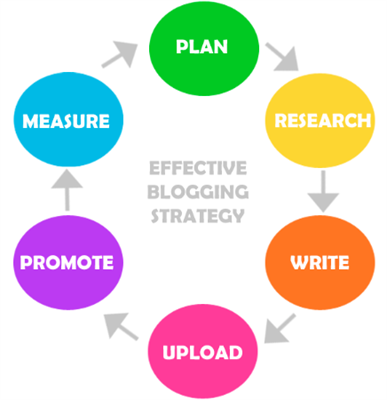Blogging isn’t hard, but blogging on a regular basis can be.
This is why it’s critical to create a blogging strategy that works for you.
According to the recent Content Marketing Institute’s survey, 46% of marketers have a documented strategy for managing content as a business asset, and there’s no question about it that you should have one too! Having a blogging strategy saves time, helps you create better content and you’ll feel like you’re not always in a mad dash to publish a post.
While the blogging process is personal and many bloggers have a different approach, we want to share one that’s working for us. It’s a systemized approach to creating content – you break the blogging process into 5 steps and do each step for all your posts together.
So, here is the practical guide to creating a blogging strategy that actually works.
Step 1: Plan
The first step to creating an effective blogging strategy is to make a publishing schedule, so you know what you want to say when, and an action items list, so you know what you need to do to accomplish your plan.
I wish I did this when I started blogging.
Instead, I created every post from scratch. I brainstormed what I wanted to say, then did my research and wrote it. It was a long process. Every post seemed like a bigger project than it should be. And the thought of repeating the process a few days later was uninspiring, especially at the beginning when our traffic was growing slowly.
Our blog felt disjointed, and since I didn’t create a blogging strategy, I never felt like I was on top of it.
Then I realized blogging is a process – while some prefer to sit down and hammer out a post every few days, I discovered the joy of planning.
You’re a blogger, which also means you’re a publisher and a content curator. Think of your blog in terms of “monthly or weekly issues” and plan accordingly.
Just like a magazine.
1. To start, what do you want to say?
Every month our content marketing team sits down and brainstorms topics we want to blog about.
We review our list of ongoing ideas (when you have an idea, write it down – you’ll be doing yourself a huge favour – we thank Chris Brogan for this concept), brainstorm new ones, pull from trending topics and review conversations we’ve had with our customers.
We also look at our best performing posts (we focus on posts that are converting prospects, not just ones that increase traffic), and which ones from our competitors are doing well.
If you’re stuck on what to say, don’t worry.
I agree with Neil Patel – you don’t have to recreate the blog idea reel – leverage what others are saying. For example, Neil suggests you analyze the posts of 20-30 of your competitors to see which ones get shared the most, and write a related post.
So, if “How To Write Magnetic Headlines” is being shared a lot, you can do a post on “5 Common Headline Mistakes and How to Avoid Them.”
You can read more about Neil’s strategy here.
You don’t need to know your exact keywords yet, but get an idea of the main thoughts you’d like to explore. Sometimes you’ll jot down how you’re going to start your post, the points you’re going to convey, and how you’re going to wrap it up. Sometimes you’ll just say, “I want to write about 10 ways to improve x” and discover those during your research.
The more focused you can be the better, as it saves time during your research so you won’t get sidetracked.
2. How often will you post?
Based on research, as often as you can! Companies who blog 3-4 times a day, are by far most successful.
But if you’re a beginner or a small business owner, then blogging 2x a week is a great starting point. So, if you’re doing a monthly plan, you’ll need to organize 8 posts. If that’s too much, start at 4 a month and go from there.
Now you’re ready to create your blogging calendar, which shows you when you’ll publish each post. Ideally you’ll post on the same days each week, as Google loves consistency. I like to put my blogging calendar on a wall above my desk, so I have a high level overview of what’s being published throughout the month.
When you know what you want to say and when you’re going to share it, you’re ready for the next step.
Step 2: Research
There are 50.000 new WordPress sites added daily. Make yours stand out by:
- Doing proper keyword research so your customers find you.
- Using research and facts to validate your thoughts.
Keyword Research
Take the ideas and topics you created in the planning phase and find the best keywords to focus on for each post. To recall, keywords are what people type into Google – they can be anything. The goal of keyword research is to find the best words that you have a high chance of ranking for, and optimize your post for that phrase.
There are a ton of resources on how to do effective keyword research. My favourites are:
- The Keyword Research Chapter from SEOmoz’s The Beginners Guide To SEO
- 12 Tips for Keyword Selection to Guide your Content Marketing SEO from the Content Marketing Institute
- We also wrote our popular Absolute Basics of SEO for Content Marketing Newbies – check it out and let us know what you think!
Use Facts
There are 3.5 billion searches on Google every day. How will your blog stand out?
This is your chance to research your topic and see what other experts are saying, so your post can add real value – while you’re not writing a research paper, adding 1 or 2 facts from reputable sources will increase your authority.
I can’t overstate the importance of using facts in your blog.
Besides your credibility, it increases the chance that people will learn something after reading your blog and come back for more.
It also shows you other posts on a similar topic, so you can include them as resources in your post. The more related you are to the content you want to rank for, the better.
Plus, it can help you build relationships with influencers.
If you include someone’s post as a resource, be sure to send them an email or tweet to let them know and thank them for creating their content. It’s a great way to get on their radar (you might get a retweet if you’re lucky), plus you’re curating great content for your readers, which is the most important goal.
Step 3: Write
Now you’ve planned what you want to say and you’ve done your research, writing should be simple.
I save this part for when I have a few hours of focused time so I can get into a flow. Early in the morning or late at night seems to be the sweet spot.
I usually follow a similar post format.
I introduce what I want to say, flush out the idea or concept, and close with a new remark, which increases the likelihood that someone will read to the end, and a question, to encourage comments. To create a blogging strategy that actually works, think about the format for your typical post – it will help you write even when you’re stuck on “how to say what you want to say.”
You don’t need to worry about using proper keywords, optimizing your post or adding links and images.
Just write.
For inspiration, read our ‘How to Overcome Your Fears and Write the Perfect First Blog Post’. It has helpful guidelines for each and every step of the writing process and we promise you’ll want to bookmark it for future reference.
Step 4: Upload
This is the fun part!
It doesn’t require a lot of thinking, so you can save it for when you’re tired or do a few minutes throughout the day between meetings or other projects.
Upload your post to your blogging platform, break it up into smaller paragraphs so it’s easy to read (43% of readers skim through blog posts, so your content must be easy to consume), add headings and links, optimize it using SEO best practices, and finally add images to make it visual.
If you’re using Spokal, this process is fast and enjoyable. In addition to our real-time SEO monitor, we integrate with creative commons images on flickr, so it’s easy to find big and beautiful photos to spice up your post.
When you’re finished, schedule your posts according to the blogging calendar you made in step 1.
Step 5: Promote
This is the step most people miss.
No matter how great your posts are, if you don’t promote them you’re missing a huge opportunity to capture your customer’s attention.
The key to promoting is to do the same thing each time.
In addition to sharing the post on your social networks (which can be easily automated with Spokal or similar tools), what else are you doing?
For example, you can schedule several tweets throughout the day when you publish a new blog post (all with slightly different copy) to increase your chances of people seeing it – and make sure to reach your followers in different time zones.
Also, send notes to everyone you mention in the post and thank them for sharing their content. Ultimately, email your post to 10-20 colleagues and customers who might enjoy reading it and ask for comments.
In addition, use the relationships you’ve built with fellow bloggers and influencers and ask them to retweet your post if they enjoyed it.
- CopyBlogger wrote a fantastic ebook on How To Effectively Promote Your Content– it’s worth reading if you want to learn more
- Check out the 12 Things You *Must* do After Writing a New Blog Post from Unbounce – it’s a good checklist to start with
Bonus Step: Metrics
Once you’ve found a blogging strategy that ensures you create content on a regular basis, you need to measure your results.
So, what should you track?
Besides the obvious traffic and social media shares, track comments. Those are a better indicator of engagement (the goal of your blog is to build relationships with people) and more importantly, track conversions. How many people read your post and become leads, either by signing up for your email list, following you on social networks or contacting you directly.
(Spokal users can track these metrics in the Post Performance page).
For example, a post that has been shared less than a post that has converted more leads suggests that the type of content is more relevant to your potential customers.
This is the step that can reveal if your goals are being achieved or not.
Conclusion: How To Create A Blogging Strategy
Since it takes 3-6 months for inbound marketing to start working, and most marketing initiatives fail within 3 months, it’s important to have an effective blogging strategy to ensure you make it past the 3 month cliff.
As you continue blogging, you’ll discover what works for you, and how you can adjust your blogging frequency and goals based on your results.
So, what do you do to create a blogging strategy that actually works?
Editor’s note:
This post was originally published in May 2013 and has been updated with new research information and links.







